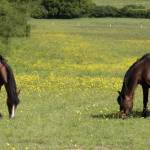Four Tips for Managing Tall Fescue and Mare, Foal Health

With the foaling season in full swing in some parts of the world, mare owners should be aware of what tall fescue looks like, why this grass is problematic, and different strategies for avoiding fescue toxicosis.
Fescue toxicosis occurs when mares ingest tall fescue that is infected with the endophytic fungus Neotyphodium coenophialum. The fungus, which lives between individual plant cells, produces a group of chemicals called alkaloids that afford drought- and insect-resistant properties to the plant.
Tall fescue is an extremely common grass; about 690,000 horses graze nearly 40 million acres of tall fescue in the United States. “Most horses, including open mares, young horses, stallions, and geldings, can all safely graze tall fescue, even if it is infected with the endophyte fungus,” shared Kathleen Crandell, Ph.D., a nutritionist for Kentucky Equine Research (KER).
Mares in the last 60 to 90 days of pregnancy, however, should not be grazed on fields of tall fescue or fed hay that contains tall fescue. Pregnant mares ingesting the endophytic alkaloids, especially ergovaline, are at risk for:
- Prolonged gestation of a month or more;
- Abortion or stillbirths;
- Premature separation of the placenta (red bag);
- Difficult birth, known as dystocia, because of the prolonged pregnancy and large foal;
- Thickened or retained placenta; and
- Decreased or absent milk production, including colostrum.
Here are four tips that owners should consider when trying to decrease or eliminate the presence of tall fescue on their property:
- Completely replace fescue-ridden fields. Of the list of tips provided here, this is likely the most expensive and time-consuming approach to choking out fescue. The idea is to remove all fescue with herbicides and to replace it with another type of grass, legume, or mixture. Endophyte-free varieties of tall fescue are available, but they aren’t as hardy. Alternatively, plant “novel” endophyte tall fescue infected with endophytes that do not produce ergovaline but still provide drought- and insect-resistance to the grass.
- Dilute endophyte-infected tall fescue fields by also planting legumes in the same field. Studies show that, in general, mares need to ingest >300 parts per billion of ergovaline to suffer fescue toxicosis. Avoid using fertilizer with excessive nitrogen because it can adversely affect legume growth. Legumes are advantageous as pasture plants because they are not susceptible to ergovaline contamination.
- Keep pastures with tall fescue cut short to allow close grazing. High concentrations of ergovaline are found in the seeds, so avoiding seed formation decreases toxin ingestion.
- Offer alternative forms of forages (such as hay cubes or pellets) to decrease fescue intake by fulfilling some of the horse’s forage requirement.
Like tall fescue, the value of perennial ryegrass is multidimensional: quick establishment following seeding, high-yielding growth, rapid regrowth following overgrazing, and sky-high palatability. A significant downside involves its production of water-soluble carbohydrates, including fructan, so perennial ryegrass is inappropriate for laminitis-prone horses. Further, ergovaline can be found in some endophyte-infected ryegrasses, so care much be given to its use.








